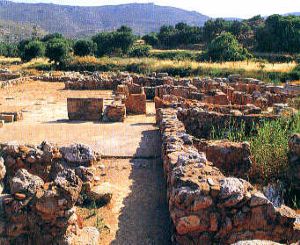|

The 'Palace' of Zakros
Captain Spratt visited Zakros in
1852. He believed this to be the ancient site of Itanos. It is not! Itanos is further
north, but Spratt's notes on the remains at Zakros led various archaeologists such as the
Italians Frederigo Halbherr (excavator of Phaistos) and
Lucio Mariani as well as Arthur Evans here. Zakros had to wait until 1901 for its first
proper excavation, however. This was undertaken by the British School of Archaeology, led by David George Hogarth. After
uncovering a number of houses (on the North-East hill) and rare Linear A tablets, floods
caused the dig to be abandoned. Hogarth had been a mere 10 metres away from the 'palace'.
Incredibly it was fully sixty years before Nicholas Platon and his team started
preliminary excavations on the 'Minoan palace' and, after many years of hard slog (still
ongoing), uncovered what we see today. In one of the most exciting digs in world
archaeology, a 'palace' was found...un-plundered.
Artefacts such as rock crystal rhytons
including a superb one of a bull (a cup in the shape of a bull, with a hole allowing the
holder to pour its contents; see pictures below), a 'cosmetic box', with a sleeping dog
lying on its lid, identical to the one found by Richard Seagar at Mochlos in 1905 (both
can be dated to the late third millennium BC and were almost certainly made by the same
craftsman) were found here (the latter in Hogarth's original dig), as well as any number of vases both of pottery and stone, such as the one
pictured. Most of the remains that we see are from the second palace (neopalatial) period,
built during the latter part of the 17th century BC, though there was a 'palace' here
dating back to the 'protopalatial' period (c1900 BC), which probably suffered the same
fate as the other protopalatial sites; death by earthquake. Pumice was found here in
quantity, leading to the belief that the eventual destruction of this and other 'palaces'
(c1450 BC) was caused by the eruption of Thera (Santorini). This theory is hugely
compelling but has been widely disregarded, as the eruption appears to have happened at
least 70 years (and in latest scientific theory, 178 years) before the destruction of the
'neopalatial' palaces.
The central court is about one third of the
size of that of Knossos (the site itself is about 1/5 of the overall size of Knossos) and
is lined in a Northeast-Southwest direction (Phaistos, Knossos and Malia are North to
South), but other than Zakros is very similar to the other 'palaces', though as I say,
somewhat smaller. The site of Zakros is very slowly sinking to the East, creating a
marsh-like environment.
|
Zakros Palace Image Library
|
The "Hall of the
Cistern" - with
an exterior diameter of seven metres and an interior diameter protected with hydraulic
plaster, or 'waterproof cement' of five metres - to the East of the Central court, is
superb. Nobody really knows what this cistern was used for; 8 steps lead you down into the
"swimming pool" (some people believe that this was its use) which had drainage
facilities enabling it to contain a constant level of water from underground springs,
rather than merely catch rainwater. It is now a home to terrapins, who are somewhat shy,
but clearly visible and audible (along with the toads!) as they throw themselves into the
water. This cistern is unique in Minoan/Mycenaean architecture, in that it is found within
the palace complex.
The geographical position of the site, and
its harbour, would have allowed trade with the near East (especially Egypt), to be carried
out, far easier than from any of the other (known) 'palace' ports'.
Further reading:
'Zakros: The
Discovery of a lost palace of Ancient Crete' by Nicholas Platon (Scribners, 1971) is a bit
dated and out of print, but well worth picking up if you can find a copy, second hand.
There is a short guide to the 'Palace' written by Costis Davaras, available on the island,
and both the 'Blue Guide' and 'Rough Guide' to Crete have sizeable sections on the site.
SJ
|

